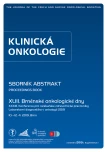-
Medical journals
- Career
Analysis of Blood Plasma MicroRNAs to Enable Identification of Patients with Pancreatic Ductal Adenocarcinoma Who Will Benefit from Surgical Resection
Authors: N. A. Gabło 1; V. Procházka 2; J. Hlavsa 2; I. Kiss 3; J. Srovnal 4; Z. Kala 2; O. Slabý 1,3
Authors‘ workplace: CEITEC – Středoevropský technologický institut, Masarykova univerzita, Brno 1; Chirurgická klinika LF MU a FN Brno 2; Klinika komplexní onkologické péče, Masarykův onkologický ústav, Brno 3; Ústav molekulární a translační medicíny LF UP v Olomouci 4
Published in: Klin Onkol 2019; 32(Supplementum1): 174-176
Category: Article
Overview
Background: Pancreatic ductal adenocarcinoma (PDAC) is the most common malignancy of pancreas, characterized by extremely poor prognosis largely due to problem with early diagnosis and lack of progress in personalization of therapy. Of all available treatment strategies, radical surgical resection of the tumour in its early stage remains the only possibility how to reach long-term survival. However, even a technically perfect surgical resection may still not provide a survival benefit for all PDAC patients. Appropriate selection of patients for surgical resection is one the important medical needs in management of PDAC patients.
Material and methods: To this study we enrolled 24 PDAC patients who underwent surgical resection and preoperatively collected their blood plasma specimends. Patients were divided into to two prognostic groups according to their overall survival – 12 patients with poor prognosis (median overall survival 10 months) and 12 patients with good prognosis (median overall survival 25 months). Small RNA sequencing technology was applied to screen for microRNAs (miRNA) with differential levels between both PDAC patient’s group. cDNA libraries were prepared using QIAseq miRNA Library Kit (Qiaqen) and sequencing by NextSeq500 instrument (Illumina).
Results: When miRNA expression profiles of the PDAC patients from good and poor prognostic groups were compared, 61 miRNAs were identified to have significantly different plasma levels between the two groups (p < 0.05). A total of 21 miRNAs showed increased expression and 40 miRNAs showed decreased expression in a group of patients with poor prognosis compared to patients with good prognosis.
Conclusion: This study demonstrated differences in miRNA expression profiles in preoperative plasma specimens of PDAC patients with short and long overall survival. Our observations indicate that after independent validations plasma miRNAs might become useful biomarkers for identification of PDAC patients having clinical benefit from surgical resection of the tumour.
This work was supported by Czech Ministry of Health, grant No. 16-31314A.
All rights reserved.
The authors declare they have no potential confl icts of interest concerning drugs, products, or services used in the study.
The Editorial Board declares that the manuscript met the ICMJE recommendation for biomedical papers.
Submitted: 8. 3. 2019
Accepted: 9. 3. 2019
Keywords:
pancreatic ductal adenocarcinoma – circulating microRNA – prognostic biomarker
Sources
1. Vincent A, Herman J, Schulick R. Pancreatic cancer. Lancet 2011; 378 (9791): 607–620. doi: 10.1016/S0140-6736 (10) 62307-0.
2. Ferlay J, Soerjomataram I, Dikshit R. Cancer incidence and mortality worldwide: sources, methods and major patterns in GLOBOCAN 2012. Int J Cancer 2015; 136 (5): E359–E386. doi: 10.1002/ijc.29210.
3. Siegel RL, Miller KD, Jemal A. Cancer statistics, 2018. CA Cancer J Clin 2018; 68 (1): 7–30. doi: 10.3322/caac.21442.
4. Rhim AD, Mirek ET, Aiello NM. EMT and dissemination precede pancreatic tumor formation. Cell 2012; 148 (1–2): 349–361. doi: 10.1016/j.cell.2011.11.025.
5. Gu S, Jin L, Zhang F. Biological basis for restriction of microRNA targets to the 3’ untranslated region in mammalian mRNAs. Nat Struct Mol Biol 2009; 16 (2): 144–150. doi: 10.1038/nsmb.1552.
6. Schanen BC, Li X. Transcriptional regulation of mammalian miRNA genes. Genomics 2011; 97 (1): 1–6. doi: 10.1016/j.ygeno.2010.10.005.
7. Vorvis C, Koutsioumpa M, Iliopoulos D. Developments in miRNA gene signaling pathways in pancreatic cancer. Future Oncol 2016; 12 (9): 1135–1150. doi: 10.2217/fon-2015-0050.
8. Galatenko VV, Galatenko AV, Samatov TR. Comprehensive network of miRNA-induced intergenic interactions and a biological role of its core in cancer. Sci Rep 2018; 8 (1): 2418. doi: 10.1038/s41598-018-20215-5.
Labels
Paediatric clinical oncology Surgery Clinical oncology
Article was published inClinical Oncology

2019 Issue Supplementum1-
All articles in this issue
- Metastatic Clear Cell Renal Carcinoma Without Evidence of a Primary Renal Tumour Mimicking Advanced Stage of Malignant Lung Tumour
- Utilization of Next Generation Sequencing in Analysis of Circulating MicroRNAs as Predictive Biomarkers for Patients with Locally Advanced Rectal Carcinoma
- Chemoembolization for Treatment of Hepatocellular Carcinoma – National Registry-Based Analysis
- Dynamic Changes in Circulating MicroRNA Levels in Liver Cancer Patients Undergoing Thermal Ablation and Transarterial Chemoembolization
- Encyclopedia of CLL Subsets – a Unique Bioinformatics Tool and Database for Analysis of Subsets of Stereotypical B-Cell Receptors in CLL
- Molecular Classification of Medullobastomas by Whole Genome Expression Profiling
- Analysis of Blood Plasma MicroRNAs to Enable Identification of Patients with Pancreatic Ductal Adenocarcinoma Who Will Benefit from Surgical Resection
- Clinical Oncology
- Journal archive
- Current issue
- Online only
- About the journal
Most read in this issue- Metastatic Clear Cell Renal Carcinoma Without Evidence of a Primary Renal Tumour Mimicking Advanced Stage of Malignant Lung Tumour
- Encyclopedia of CLL Subsets – a Unique Bioinformatics Tool and Database for Analysis of Subsets of Stereotypical B-Cell Receptors in CLL
- Molecular Classification of Medullobastomas by Whole Genome Expression Profiling
- Dynamic Changes in Circulating MicroRNA Levels in Liver Cancer Patients Undergoing Thermal Ablation and Transarterial Chemoembolization
Login#ADS_BOTTOM_SCRIPTS#Forgotten passwordEnter the email address that you registered with. We will send you instructions on how to set a new password.
- Career

